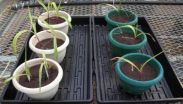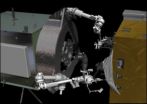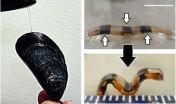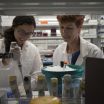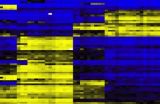(Press-News.org) URBANA, Ill. – Soybean improvement through plant breeding has been critical over the years for the success of the crop. In a new study that traces the genetic changes in varieties over the last 80 years of soybean breeding, researchers concluded that increases in yield gains and an increased rate of gains over the years are largely due to the continual release of greater-yielding cultivars by breeders.
"This research in some ways looks back and informs us how soybean varieties have changed. It's useful to document these traits and changes," said Brian Diers, a University of Illinois plant breeder and researcher on the study. "We can show that we really have been successful at increasing yield."
But this study is also about the future of the soybean crop.
"The study has actually created quite a lot of interest among soybean breeders because they want to understand what's happened, and when we look at physiological traits, we can see what has been changed. This gives us clues about what traits we should focus on in breeding for future increases based what has been inadvertently changed over time as we have selected for yield," he said.
Diers and a multi-institutional team of researchers evaluated historic sets of 60 maturity group (MG) II, 59 MG III, and 49 MG IV soybean varieties, released from 1923 to 2008, in field trials conducted in 17 states and one Canadian province during 2010 to 2011.
The experiments included plant introductions (PIs) and public cultivars obtained from the USDA Soybean Germplasm Collection housed at the National Soybean Research Center at the U of I, as well as from varieties provided by Monsanto, Pioneer, and Syngenta.
In the process of documenting the genetic changes, the researchers observed an increase in yields over the past 80 years that is equivalent to one-third of a bushel per acre per year increase.
Diers said that the researchers estimated that about two-thirds of the yield increases in farmer's fields are due to new varieties that breeders have introduced with the other third due to other reasons such as improved agronomic practices.
"When we compare old varieties to new varieties, the new varieties do yield much better than the old varieties. When we look at the data more closely, the yield increases have actually accelerated starting in the 1960s and 1970s. It's different for each maturity group, but current yield increases are greater than they were earlier," Diers said.
This research also showed that when compared to old varieties, plants in the new varieties are shorter in height, mature later, lodge less, and have seeds with less protein and greater oil concentration.
"The new varieties tend to mature later within these maturity groups, which is something that theoretically shouldn't happen because we classify these varieties based on when they mature. So theoretically MG II varieties should mature at the same time now as one back in the 1970s, but this is not the case," Diers said. "Probably over time, people have been selecting varieties that are a little bit later and later, and these changes have accumulated. In some ways, it's not a bad thing, because farmers are planting earlier than they did back in the 1970s so they actually need varieties that will mature later than back then. That's not a bad thing."
Other traits reported as changed over time included earlier flowering time, which has resulted in an expanded reproductive period. "We didn't know that this reproductive period was expanding, and we are now asking whether breeding for an even longer reproductive period could further increase yields. Other studies have looked at the interaction of planting date by year of release and have shown new varieties can utilize earlier planting dates better than old varieties," Diers said.
With soybean being a leading source of protein and oil for human food, animal feed, and other products, global rates of yield increases for the crop will need to keep up with demand in the future.
"By understanding how we've made these changes to date, it can help us understand how we can further improve yields and increase the rate of gain," Diers said.
Diers plans to study ways to increase the rate of genetic gains using more modern breeding techniques.
"Most of the yield increases are the result of breeders selecting better combinations of genes that can allow plants to take sunlight and produce more seed from that sunlight. We don't know what genes breeders are selecting that are resulting in these increases, for example, where in that pathway from the sunlight hitting the canopy to producing seed where this occurs. Breeders, by selecting new varieties that have more yield, are able to make this progress without really understanding the mechanism," Diers said.
INFORMATION:
The study, "Genetic Improvement of US Soybean in Maturity Groups II, III, and IV," was recently published in the Journal of Crop Science and can be accessed online at https://www.crops.org/publications/cs/view/first-look/c13-08-0579.
Co-authors of the study include Keith Rincker, Randall Nelson, James Specht, David Sleper, Troy Cary, Silvia R. Cianzio, Shaun Casteel, Shawn Conley, Pengyin Chen, Vince Davis, Carolyn Fox, George Graef, Chad Godsey, David Holshouser, Guo-Liang Jiang, Stella K. Kantartzi, William Kenworthy, Chad Lee, Rouf Mian, Leah McHale, Seth Naeve, James Orf, Vaino Poysa, William Schapaugh, Grover Shannon, Robert Uniatowski, Dechun Wang, and Brian Diers.
Look back at US soybeans shows genetic improvement behind increased yields
2014-03-05
ELSE PRESS RELEASES FROM THIS DATE:
Fertility prospects following ectopic pregnancy
2014-03-05
WINSTON-SALEM, N.C. – March 5, 2014 – Preserving a fallopian tube following an ectopic pregnancy seems like it would favor a woman's fertility prospects, right?
A new study from Wake Forest Baptist Medical Center looked at pregnancy outcomes in regards to the two surgical treatments for ectopic pregnancy -- salpingectomy, in which the affected fallopian tube is removed, or salpingotomy, in which the tube is preserved.
The aim of the study, said co-author Tamer Yalcinkaya, M.D., a reproductive endocrinologist at Wake Forest Baptist, was to assess whether salpingotomy ...
Maize and bacteria: A 1-2 punch knocks copper out of stamp sand
2014-03-05
Scientists have known for years that together, bacteria and plants can remediate contaminated sites. Ramakrishna Wusirika, of Michigan Technological University, has determined that how you add bacteria to the mix can make a big difference.
He has also shed light on the biochemical pathways that allow plants and bacteria to clean up some of the worst soils on the planet while increasing their fertility.
Wusirika, an associate professor of biological sciences, first collected stamp sands near the village of Gay, in Michigan's Upper Peninsula. For decades, copper mining ...
NASA tests new robotic refueling technologies
2014-03-05
NASA has successfully concluded a remotely controlled test of new technologies that would empower future space robots to transfer hazardous oxidizer – a type of propellant – into the tanks of satellites in space today.
Concurrently on the ground, NASA is incorporating results from this test and the Robotic Refueling Mission on the International Space Station to prepare for an upcoming ground-based test of a full-sized robotic servicer system that will perform tasks on a mock satellite client.
Collectively, these efforts are part of an ongoing and aggressive technology ...
OU study suggests non-uniform climate warming global
2014-03-05
A recent University of Oklahoma study of five decades of satellite data, model simulations and in situ observations suggests the impact of seasonal diurnal or daily warming varies between global regions affecting many ecosystem functions and services, such as food production, carbon sequestration and climate regulation. The effects of non-uniform climate warming on terrestrial ecosystems is a key challenge in carbon cycle research and for those making future predictions.
Jianyang Xia, a research associate in the OU College of Arts and Sciences, says the impact of non-uniform ...
A small step toward discovering habitable earths
2014-03-05
University of Arizona researchers snapped images of a planet outside our solar system with an Earth-based telescope using essentially the same type of imaging sensor found in digital cameras instead of an infrared detector. Although the technology still has a very long way to go, the accomplishment takes astronomers a small step closer to what will be needed to image earth-like planets around other stars
"This is an important next step in the search for exoplanets because imaging in visible light instead of infrared is what we likely have to do if we want to detect planets ...
Researchers find potential target for drug to treat allergic asthma
2014-03-05
COLUMBUS, Ohio – An enzyme that helps maintain immune system function by "throwing away" a specific protein has a vital role in controlling symptoms of allergic asthma, new research in mice suggests.
The finding suggests that this enzyme, called Cbl-b, could be a target for drugs used to treat allergic asthma and other autoimmune disorders.
This new study, led by Ohio State University researchers, is the first to link Cbl-b to allergic asthma in an animal model.
The findings parallel results from a 2012 Yale study in humans, which suggested that a mutation in the ...
Pumping iron: A hydrogel actuator with mussel tone
2014-03-05
Protein from a small, tasty mollusk inspired Michigan Technological University's Bruce P. Lee to invent a new type of hydrogel actuator.
Hydrogels are soft networks of polymers with high water content, like jello. Because of their soft, gentle texture, they have the potential to interact safely with living tissues and have applications in a number of medical areas, including tissue engineering. Lee, an assistant professor of biomedical engineering, wanted to make a hydrogel that wouldn't just sit there.
"Hydrogels that can change shape on command could be used to deliver ...
Going viral to target tumors
2014-03-05
March 5, 2014, New York, NY– A Ludwig Cancer Research study suggests that the clinical efficacy of checkpoint blockade, a powerful new strategy to harness the immune response to treat cancers, might be dramatically improved if combined with oncolytic virotherapy, an investigational intervention that employs viruses to destroy tumors.
Published today in the journal Science Translational Medicine, the study evaluated a combination therapy in which the Newcastle disease virus (NDV), a bird virus not ordinarily harmful to humans, is injected directly into one of two melanoma ...
Biomarkers of cell death in Alzheimer's reverse course after symptom onset
2014-03-05
Three promising biomarkers being studied to detect Alzheimer's disease in its early stages appear to undergo a surprising shift as patients develop symptoms of dementia, researchers at Washington University School of Medicine in St. Louis report.
Scientists use the biomarkers to assess brain changes linked to the disease in research volunteers. The levels of markers of neuronal injury increase in the spinal fluid for a decade or more before the onset of dementia, but in a new twist, the research shows for the first time that they later reverse course, decreasing as symptoms ...
An inventive new way to profile immune cells in blood
2014-03-05
ROVIDENCE, R.I. [Brown University] — When a person becomes sick or is exposed to an unwelcome substance, the body mobilizes specific proportions of different immune cells in the blood. Methods of discovering and detecting those profiles are therefore useful both clinically and in research. In a new paper in the journal Genome Biology, a team of scientists describes a new and uniquely advantageous way to detect them.
All the current means of counting immune cells in a blood sample require whole cells, said Karl Kelsey, professor of epidemiology at Brown and corresponding ...
